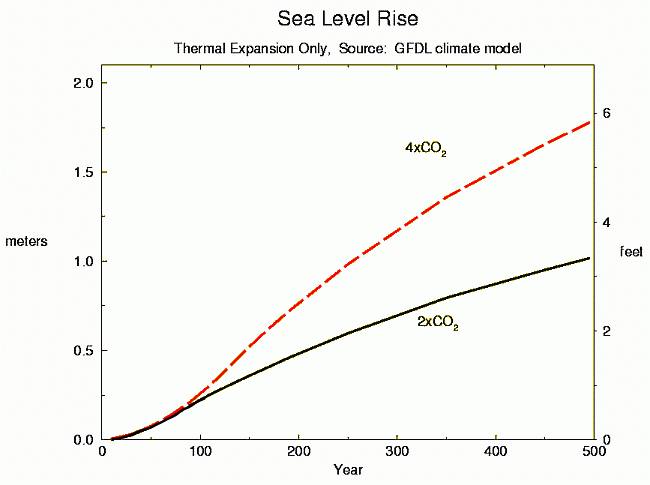Projected_change_in_global_sea_level_rise_if_atmospheric_carbon_dioxide_concentrations_were_to_either_quadruple_or_double_(NOAA_GFDL).png
Summary
| Description Projected change in global sea level rise if atmospheric carbon dioxide concentrations were to either quadruple or double (NOAA GFDL).png |
English:
This graph shows the projected change in global
sea level rise
if
atmospheric carbon dioxide
(CO
2
) concentrations were to either quadruple or double. Edited quote from the cited public-domain source: In response to
greenhouse gas
warming, sea level is expected to rise due to the
thermal expansion
of sea water as the ocean warms. Because the deep ocean will warm much more slowly than the upper ocean, the thermally driven rise in sea level is expected to continue for centuries after atmospheric CO
2
stops increasing. The graph shows the increase of global mean sea level in the
GFDL
4xCO
2
coupled
climate model
experiment. Even though CO
2
no longer increases after year 140, sea level continues to rise steadily well beyond year 500. The final equilibrium sea level change in the model is 1.9
meters
for a CO
2
doubling (not shown) which is roughly the level attained in the CO
2
quadrupling experiment after 500 years. The equilibrium rise for the quadrupling experiment has not yet been simulated.
These sea level rise projections are the expected changes due to thermal expansion of sea water alone, and do not include the effect of melted continental ice sheets . With the effect of ice sheets included, the total rise could be larger by a substantial factor. However, projections of the contribution of the ice sheets to future sea level rise are not presented here due to the difficulties of performing a credible calculation. For reference, the volume of ice in the Greenland and Antarctica ice sheets is equivalent to a sea level rise of 7 and 73 meters, respectively (IPCC, 1995) (see current sea level rise for more information). Details on the simulation The results presented are based on several multi-century integrations of a GFDL global coupled ocean-atmosphere model. The model resolution is about 4 degrees latitude. In the quadrupled (4xCO 2 ) experiment, CO 2 increases at 1% per year (compounded) to a level four times that of the present climate. After this 140 year "ramp-up" period, the model is integrated for several more centuries to examine the long time response of the climate system, including the deep ocean. For comparison, results are also presented from the 2xCO 2 experiment, in which CO 2 increases by a factor or two in the first 70 years, and then is constant at 2xCO 2 for several more centuries of model integration. |
| Date | |
| Source | Geophysical Fluid Dynamics Laboratory - Climate Impact of Quadrupling CO 2 [1] , Princeton, NJ, USA: NOAA GFDL, (Please provide a date or year) |
| Author | NOAA GFDL |
|
This is a
retouched picture
, which means that it has been digitally altered from its original version. Modifications:
(1) Changed color of graph's background from yellow to white, (2) changed solid red line plotted on graph to a dashed red line (ensures the graph can be used by color-blind users and printed using a grey-scale printer)
.
|
Licensing
| Public domain Public domain false false |
|
|
This work is based on a work in the
public domain
. It has been digitally enhanced and/or modified. This derivative work has been (or is hereby) released into the
public domain
by its author,
Enescot
. This applies worldwide.
In some countries this may not be legally possible; if so:
|
Captions
Add a one-line explanation of what this file represents

